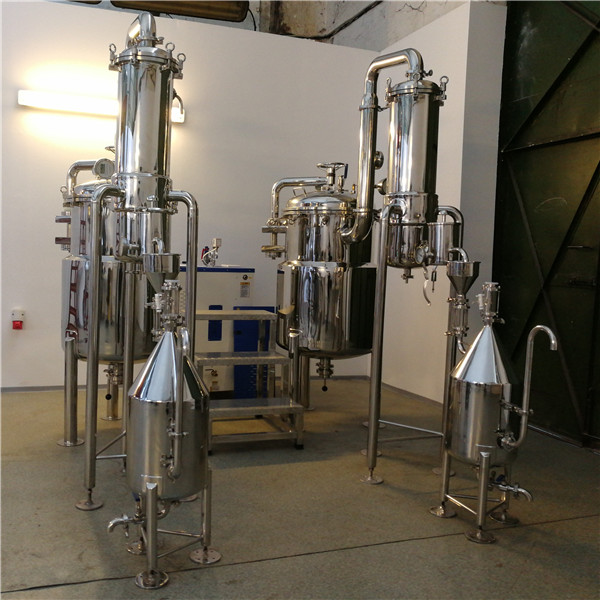We know that aromatherapy essential oils are volatile aromatic compounds extracted from plants. Flowers, leaves, fruits, seeds, roots, stems and other parts of plants can be used to extract plant aromatherapy essential oils. The location where aromatherapy essential oils are extracted determines the different properties of the essential oils. The extraction of aromatherapy essential oils is an ancient science and a skillful art that has a history of thousands of years. Among the many essential oil extraction methods, distillation is the oldest and most common way of extracting essential oils. Common distillation methods include water distillation, steam distillation, and water vapor distillation. The differences between these three distillation methods are explained below.

1. Hydro distillation method: soak plant flowers in water and boil them, which is equivalent to stewing. The essential oils in the plants are released into the boiling water and flow out with the steam, and are separated from the water after condensation. This distillation method is mainly used for some plant flowers that are dense and have low water content, such as common clove, star anise, fennel and other spice essential oils. Steam distillation is difficult to destroy the plant cells, so water distillation is used to extract them.
2. Steam distillation: The steam distillation method is the opposite of the water distillation method. It is a distillation method in which the plant flowers are placed in a position not in contact with boiling water, and the plant flowers are heated by the water vapor to evaporate the essential oils in the flowers together with the steam. Method, this distillation method is generally suitable for essential oils with soft texture and large water content in plant flowers, such as jasmine essential oil, rose essential oil and other essential oils.
3. Hydrosteam distillation method: Water vapor distillation method is a distillation method between water vapor distillation method and water distillation method. Simply put, the plant flowers are placed on the water surface, and the flowers are in contact with the water but not in contact with the water. The method of complete contact is equivalent to that when the water boils, the plants and flowers will come into contact with the water. If it does not boil, there will be little contact. Some friends will ask why there is still water vapor distillation when there are steam distillation and water distillation. This is because the yield of essential oils is not high if steam distillation is used, and water distillation may destroy some essential oil components. Therefore, a compromise method is adopted to increase the yield and preserve the richness of essential oil components to the maximum extent.
The order of appearance of the three distillation methods, hydro distillation, steam distillation, and hydrosteam distillation, is that the oldest is definitely hydro distillation, and it is also the simplest. To put it shamelessly, as long as you have a pressure cooker at home and can find flowers, you can do it yourself It can also be done. Steam distillation is followed by hydro distillation because it is found that some plant flowers will decompose quickly when soaked in water, thereby reducing the quality and yield of essential oils. Science and technology are always progressing. When people discovered steam distillation, they also found that the yield of distillation was not enough, so the hydrosteam distillation method, a distillation method that compromised yield and quality, appeared.
Although from a technical perspective, it is very simple to obtain plant essential oils by distillation. However, in actual production, the production equipment will make the steam more controllable by controlling the production pressure. Both temperature and humidity can be best controlled in a balanced state. Because these pressures and steam temperatures are critical to the yield and quality of essential oils. This is why many times some people distill plant essential oils at home, which should produce oil, but in the end they get only hydrosol, or only very little essential oil appears. This is completely inconsistent with the oil production rate stated in aromatherapy literature. When it comes to distillation methods, there are still some people in the market who are promoting that their essential oils are distilled in ancient copper pots. I don’t know why people’s eyes light up when they hear the word ancient method. Of course we need to preserve and praise traditional culture. But if the ancient method is really so good, why don’t today’s industrial production use copper pots? Of course you can also say that copper pots are expensive? Of course there are reasons for this. But the main reason is that copper equipment is prone to chemical reactions with essential oils during distillation, thus affecting the quality of essential oils. As for why the ancients used copper pots for distillation, that was determined by historical conditions. If stainless steel had been available in ancient times, I think the ancients would have been more willing to use stainless steel. Of course you will say why not use aluminum equipment. You see, large-scale essential oil packaging is made of aluminum. Be sure that aluminum will not react with essential oils. The reason why aluminum does not react with essential oils is because aluminum will be oxidized after production and form a dense film on the metal surface. This film is the key to preventing the reaction between aluminum and essential oils. Therefore, if you are a professional essential oil dealer, when you purchase new essential oil aluminum bottles, you usually need to store them for more than one year before using them. Professional essential oil extraction equipment is made of stainless steel. As for why stainless steel is used, of course it is also to prevent the essential oils from reacting with the equipment and thus affecting the quality of the essential oils. So the so-called ancient copper pot distillation is a gimmick that everyone will know after just looking at it. If it is a small-scale production, the best equipment should be glass instruments. As for why, you should understand if you think about why most chemical instruments are glass instruments. Because of its stability, except being easily broken.
Oleoresins Introduction
Stainless Steel Mixing Equipment Application
Plate Centrifuges Application
Contact: Project Manager
Phone: +86-18120438367
Tel: +86-18120438367
Email: info@tycoretech.com
Add: No. 1, Optics Valley Avenue, East Lake New Technology Development Zone, Wuhan, Hubei, China
We chat
